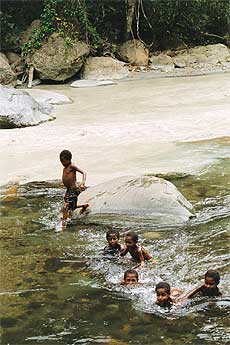Auga-Angabanga Watershed
Papua New Guinea | Goilala : DRD Gold

Children swim at a 'Y' in the Auga River system, where DRD/TGM dumps over 160,000 tonnes of mine waste annually.
Photo: Oxfam Australia
Every year in Papua New Guinea, South African mining company Durban Roodepoort Deep Ltd (DRD Gold) dumps more than 160,000 tons of contaminated mine waste directly into the Auga-Angabanga river system.
Even worse, DRD Gold transports everything to and from the Tolukuma Gold Mine (TGM) by helicopter, including cyanide which is used for ore extraction. This risky transportation system failed in 2000 when one ton of cyanide was dropped from a helicopter over the Yaloge River Valley on the way to the mine. Community members attribute up to six deaths to the cyanide spill.
Health Impacts
The mine has had other negative impacts on the community. Tolukuma's women and men complained about unexpected deaths and diseases, environmental pollution, increased violence and sexual assault, noise pollution and social upheaval. On top of that, they allege a lack of promised community benefits and infrastructure development by the company, and ongoing mine exploration without community consent or compensation.
Local residents decided they wanted to formally complain to the mine's owner DRD Gold, a company based in South Africa, but listed on the Australian Stock Exchange. In 2001, they made a formal request for help to the Oxfam Australia Mining Ombudsman.
Community Identifies Threats Posed by Mine

Photo: Grant Walton/CERD
The Mining Ombudsman met with community men and women from the Auga and Dilava Valley, some of whom walked for days to discuss their concerns, which included:
- Environmental pollution, which they attribute to the dumping of over 160,000 tons of mine waste annually into the Auga/Angabanga Rivers.
- Increased river sedimentation and flow causing flash floods, which have been blamed for sweeping away a child, and making the river difficult or impossible to cross.
- Illnesses and deaths which the community women and men attribute to drinking from and washing in the polluted river.
- Threats to food security.
- Noise and other disturbances associated with TGM's use of helicopters.
- Lack of informed consent concerning TGM's ongoing exploration activities.
- The lack of local infrastructure and development, especially roads and health facilities.
- Increased social problems, including alcoholism and violence.
- Poor communication and the company's lack of transparency regarding information disclosure.
Oxfam Reacts to DRD Gold
DRD Gold did not respond to the community's grievances as detailed in the Omsbudsman's three letters sent to the company in 2001 and 2002. But DRD Gold did react immediately to the release of the Mining Ombudsman Annual Report 2002 through a media statement disclosing and rebutting the issues raised by the Mining Ombudsman.
The Oxfam Australia Mining Ombudsman Case Report: Tolukuma Gold Mine released in September 2004 recommends that DRD Gold undertake several measures to address and resolve community grievances, including:
- respecting the right of local people to free, prior and informed consent to exploration and mining projects;
- following internationally accepted guidelines on the packaging, handling and transportation of cyanide and other materials; and
- compensating individuals, groups or communities who have suffered a loss of livelihood or assets as a direct result of the company's mining operations.
For more information:
- Oxfam America: Case Report on Tolukuma Gold Mine. 2004.
- Mineral Policy Institute: Tolukuma.
Tagged with: public health, papua new guinea, oxfam, mining, international, gold, cyanide
Follow Earthworks